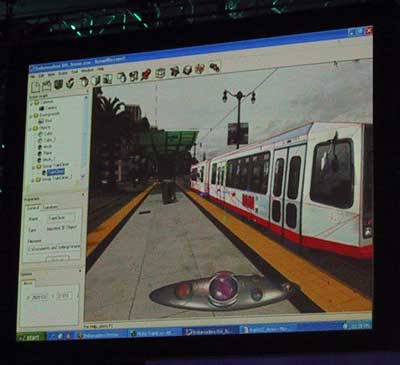Intel Developer Forum Spring 2002 - Day 1
by Anand Lal Shimpi on February 25, 2002 5:53 PM EST- Posted in
- CPUs
What do a 3GHz Pentium 4, a digital camera and the Matrix 2 have in common?
The first demonstration was one to show off a couple of technologies including software by a company called Realviz. Realviz happens to be invested in by Intel and thus the presence of their technology at IDF requires no explanation. The technology that Realviz has developed allows for a form of image based content creation.

The train in this picture is a 3D model generated from a digital photo using
a regular digital camera. Even more impressive is that the entire environment
is an interactive 3D world also generated from regular 2D digital stills taken
using a consumer level digital camera.
Using a digital still camera and the Realviz technology you are able to create a 3D world and 3D models from 2D digital still images. Imagine being able to take a bunch of pictures of an environment and stitch them together in a 3D world. This you'll know is already possible but the beauty of this demonstration was they actually created a 3D environment with actual 3D props also generated from 2D stills and made a movie out of them all. Using a few stills of Craig Barrett it was possible to create a fairly convincing 3D model of him on a snowboard tricking off of objects in a 3D world, all generated from digital stills. And of course all of this was done on an air-cooled 3GHz Pentium 4 processor.
This technology has apparently been licensed by Escape for use in some way with the upcoming sequel to the Matrix.
Some words on Technology
Mr. Barrett also had some things to say about forthcoming Intel technologies, talking about the future of CMOS transistors and even what lies ahead. As it stands, for the next 15 years Mr. Barrett saw CMOS transistors and CMOS based microprocessors to evolve to the following general characteristics:
- 2 billion transistors
- 30GHz clock frequencies
- 10nm (0.01-micron) transistors
- Processing power of 1 trillion instructions per second
- Built on 300nm (12") wafers eventually moving to 18" wafers and beyond
A quick video of Intel's D1C fab, the world's first 300nm - 0.13-micron manufacturing plant followed as we moved into the next demonstration.










1 Comments
View All Comments
Dr AB - Monday, May 11, 2020 - link
30GHz in next 15 years ..?? Lol what a joke xD clearly they had no realistic insight of the future or may be they were still too obsessed with clock frequencies.10nm? next year we will see 5nm but they (intel) are still stuck on 10nm.